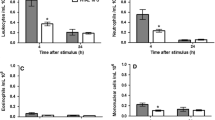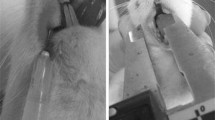Abstract
The changes in histamine and prostaglandins (PGE2 and PGF) in carrageenan-induced acute inflammation were studied in 6 day old air pouches in mice. A significant elevation of exudate histamine was found 1 hour after the carrageenan injection. Highest vascular permeability at the site of inflammation was also found at 1 hour. Both PGE2 and PGF showed steady increases in the pouch exudate and reached significantly higher levels at 24 hours. The present findings thus suggest that histamine is involved in the early phase of carrageenan-induced inflammation by enhancing vascular permeability. The increases in PGE2 and PGF appear to be closely correlated with the increased exudate cell accumulation. This leads us to suggest that they are likely to be involved in the exudate cell activity rather than in enhancing the vascular permeability which was found to decrease at 4 hours after the carrageenan injection.
Similar content being viewed by others
References
G. B. Ryan and G. Majno,Acute inflammation. A review. Am. J. Pathol.86, 185–276 (1977).
J. C. W. Edwards, A. D. Sedgwick and D. A. Willoughby,The formation of a structure with the features of synovial lining by subcutaneous injection of air. An in-vitro tissue culture system. J. Pathol.134, 147–156 (1981).
A. D. Sedgwick, Y. M. Sin, A. R. Moore, J. C. W. Edwards and D. A. Willoughby,Effects of local administration of hydrocortisone on cartilage degradation in vivo. Ann. Rheum. Dis.43, 418–420 (1984).
Y. M. Sin, A. D. Sedgwick, A. Moore, and D. A. Willoughby,Studies on the clearance of calcium pyrophosphate cyrstals from facsimile synovium. Ann. Rheum. Dis.43, 487–492 (1984).
A. D. Sedgwick, Y. M. Sin, J. C. W. Edwards and D. A. Willoughby,Increased inflammatory reactivity in newlyformed lining tissue. J. Pathol.41, 483–495 (1983).
A. L. Ronnberg and R. Hakanson,A simplified procedure for the fluorometric determination of histamine in rat stomach. Agents and Actions14, 195–199 (1984).
D. M. Olson, S. J. Lye, K. Skinner and J. R. G. Challis,Early changes in prostaglandin-concentrations in ovine maternal and fetal plasma, amniotic fluid and from dispersed cells of intrauterine tissue before the onset of ACTH-induced preterm labour. J. Reprod. Fertil.71, 45–55 (1984).
Y. M. Sin, A. D. Sedgwick, E. P. Chea and D. A. Willoughby,Mast cells in newly formed lining tissue during acute inflammation: a six day air pouch model in the mouse. Ann Rheum. Dis.45, 873–877 (1986).
F. Capasso, C. J. Dunn, S. Yamamato, D. A. Willoughby and J. P. Giroud,Further studies on carrageenan-induced pleurisy in rats. J. Pathol.116, 117–124 (1975).
M. Radermecker and M. P. Maldague,Depression of neutrophil chemotaxis in atopic individuals. An H 2 histamine receptor response. Int. Arch. Allergy Appl. Immunol.65, 144–152 (1981).
R. Anderson, A. Glover and A. R. Rabson,The in vitro effects of histamine and metiamide on neutrophil motility and their relationship to intracellular cyclic nucleotide levels. J. Immunol.118, 1690–1696 (1977).
N. Hirasawa, K. Ohuchi, M. Watanabe and S. Tsurufuji,Role of endogenous histamine in postanaphylactic phase of allergic inflammation in rats. J. Pharmacol. Exptl. Therap.241, 967–973 (1987).
B. V. Robinson,Histamine receptor agonists and antagonists on granulocyte adherence. J. Pharm. Pharmacol.34, 458–461 (1982).
A. L. Willis,Release of histamine, kinin and prostaglandins during carrageenan-induced inflammation in the rat. InProstaglandins, Peptides and Amines. (Ed. P. Matagazz) Academic Press, New York, pp. 31–38 (1969).
M. Tissot, D. Regoli and J. P. Giroud,Bradykinin levels in inflammatory exudates. Inflammation9, 419–424 (1985).
T. J. Williams and P. J. Piper.The action of chemically pure SRS-A on the microcirculation in vivo. Prostaglandins79, 779–789 (1980).
T. J. Williams and J. Morley,Prostaglandins as potentiators of increased vascular permeability in inflammation. Nature (London)246, 215–217 (1973).
A. D. Sedgwick and P. Lees,Studies of eicosanoid production in the air pouch model of synovial inflammation. Agents and Actions18, 429–438 (1986).
G. A. Higgs and L. J. F. Youlten,Prostaglandin production by rabbit peritoneal polymorphonuclear leucocytes in vitro. Br. J. Pharmacol.44, 330 (1972).
P. Crunkhorn and A. L. Willis,Cutaneous reactions to intradermal prostaglandins. Br. J. Pharmacol.41, 49–56 (1971).
D. A. Willoughby,Effects of Prostaglandins PGF 2 and PGE1 on vascular permeability. J. Pathol. Bact.96, 381–387 (1968).
K. Ohuchi, H. Sato and S. Tsurufugi.The effects of prostaglandin F 2 on vascular permeability and collagen and noncollagen protein synthesis of preformed chronic carrageenin granuloma in rats. Biochem. Pharmacol.26, 2049–2053 (1977).
Author information
Authors and Affiliations
Rights and permissions
About this article
Cite this article
Sin, Y.M., Tan, C.H. & Chan, S.F. Changes in histamine and prostaglandins in acute inflammatory air pouch in mice. Agents and Actions 28, 98–102 (1989). https://doi.org/10.1007/BF02022988
Received:
Accepted:
Issue Date:
DOI: https://doi.org/10.1007/BF02022988




